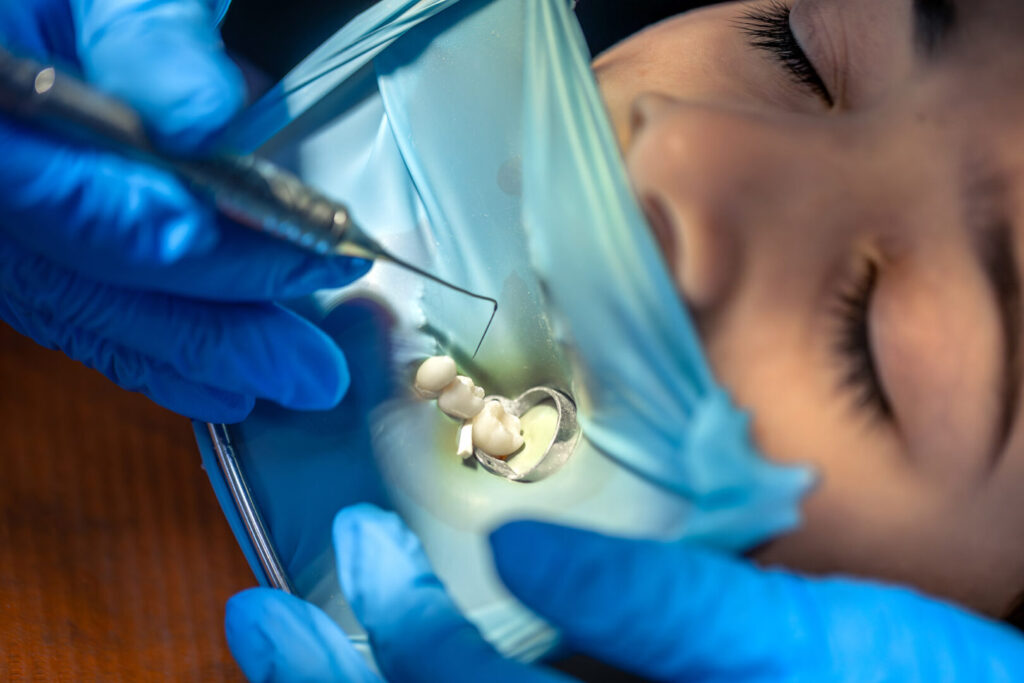Dental discomfort can be brushed off, but when pain becomes persistent or worse over time, it might mean something deeper, literally. Did you know your symptoms (severe toothache, sensitivity or swelling) could mean you need root canal treatment?
How do you know if there’s a problem with the pulp or root of a tooth? In dental anatomy, the root is the part of the tooth that anchors it to the jawbone and contains the pulp, nerves and blood vessels. During root canal treatment, the primary focus is the tooth’s root canal system, including the pulp chamber and root canals.
Root canal treatment is a reliable and comfortable solution for your persistent pain. Thankfully, a root canal procedure is a safe and effective way to remove infection, relieve pain, save your tooth, and maintain its function.

What Is Root Canal Treatment?
Root canal treatment, also known as endodontic therapy, is a procedure to remove infection from a tooth and protect it from further damage. It targets the pulp, the soft tissue inside each root canal that contains nerves, blood vessels, and connective tissue.
Pulp inflammation or infection is the main reason root canal treatment is needed, as it can cause persistent pain, swelling or abscess. If left untreated, it can spread and cause complications such as abscess formation, damage to surrounding teeth or bone and even life-threatening conditions.
A successful root canal in Singapore preserves your natural tooth, helps maintain bite alignment and normal chewing without having to extract or use more invasive alternatives like implants or bridges. The procedure involves removing the infected pulp, cleaning and disinfecting the inner canal and sealing it with a biocompatible material called gutta-percha. Done under local anaesthesia, it’s no more uncomfortable than a standard filling.
You should seek treatment as soon as possible to prevent further complications and preserve your oral health. Root canal treatment can save your tooth, relieve pain and restore normal function.

What to Expect during Your First Consultation
When you come in worried about pain or swelling, our dental team at TEETH @ Tiong Bahru doesn’t rush straight into treatment. We sit down, listen to what you’ve been feeling, and run a proper check. This usually means a few quick tests:
- Digital X-rays
- Gentle tap test
- Electric pulp test to see if the nerve inside the tooth is still alive
We’ll also ask about your medical history, as some conditions or medications can affect how we plan your care. By the end of the first visit, you’ll know exactly what’s going on, whether a root canal is the best way forward, and roughly how many appointments you’ll need.

Why Root Canal Treatment?
Root canal treatment is needed for a tooth affected by deep infection or inflammation. Root canal therapy removes the infected tissue, disinfects the canal and seals the tooth to prevent re-infection. More than just pain relief, the treatment protects surrounding teeth and tissues from the spread of infection. By keeping your natural tooth, you help maintain proper bite function, facial structure and jawbone health and reduce the need for extraction or more invasive solutions like implants or bridges.
When followed by a substantial restoration, such as a dental crown, a root canal-treated tooth can function normally for decades. It’s a safe and effective way to restore comfort, preserve your smile and protect your long-term oral health.

When Is Root Canal Treatment Needed?
A root canal is needed when the soft tissue inside your tooth – the pulp – becomes inflamed or infected. Common signs include lingering pain, sensitivity to heat or cold, swelling or tooth discolouration. Your dentist will evaluate these symptoms through a clinical exam and diagnostic tools, such as X-rays, to determine whether the pulp is compromised. If the tooth can still be saved, a root canal is the best solution.
You may need root canal treatment if you have persistent tooth pain, sensitivity to heat or cold, swelling or tooth discolouration, especially if these symptoms are caused by deep decay, trauma, deep fillings or infections that can lead to an abscess.
A crown is usually placed afterwards to restore strength and function. Treatment as soon as possible not only relieves discomfort but also preserves your natural tooth and helps you avoid more invasive procedures down the line.

Is A Root Canal Painful?
Despite its reputation, root canal treatment is generally no more uncomfortable than a standard filling. Modern dental techniques and adequate local anaesthesia make the procedure pain-free and straightforward.
Some tenderness or sensitivity may occur in the days following treatment, but this is usually mild and short-lived. Over-the-counter pain relief is often all you need to manage any pain. Complications like lingering discomfort or infection are rare and can be managed with follow-up care.
Follow your dentist’s aftercare instructions and attend any recommended reviews, and you’ll have a smooth recovery and long-term relief from dental pain.

Success Rate of Root Canal Treatments
Root canal treatment has a high success rate of 85% to 97% when performed with modern techniques and procedures. When combined with proper restoration, usually a dental crown and good oral hygiene, a treated tooth can last for decades, often for the rest of its life.
Factors such as the extent of the infection, the complexity of the tooth’s root structure and a patient’s commitment to aftercare all influence the long-term success of the procedure. Regular dental check-ups and timely intervention when issues arise are key to maintaining results.

Root Canal Treatment Price in Singapore
The cost of root canal treatment in Singapore depends on several factors, including the tooth’s location and the number of root canals requiring treatment. The following price of a root canal in Singapore excludes the cost of a final protective crown:
- Incisors, canines and premolars, the fee typically ranges from $491.00 to $872.00.
- Molars, which have more complex anatomy, can cost between $927.00 to $1,199.00.
At TEETH @ Tiong Bahru, we prioritise transparency. Additional procedures or re-treatment may increase the overall cost. The price per tooth for a dental crown can range from $1,199.00 to $1.889.50, depending on the material. You’ll receive a clear cost breakdown before any treatment begins, allowing you to make informed decisions.
CHAS / PG / Merdeka subsidies (per treatment, as of 2026):
| Card Type | Front Tooth | Premolar | Molar |
| CHAS Blue | Up to $326.00 | Up to $2462.50 | Up to $584.50 |
| CHAS Orange | Up to $217.50 | Up to $308.500 | Up to $389.50 |
| Merdeka Pioneer | Up to $331.00 $336.00 | Up to $467.50 $472.00 | Up to $589.50 $594.50 |
In addition, from mid-2026, seniors aged 60 and above can tap on Flexi-MediSave to offset up to $400.00 per year for root canal treatments and permanent crowns at CHAS dental clinics and public healthcare institutions.
We’ll check your card and let you know the exact out-of-pocket amount before you commit, and make sure the root canal treatment cost works for you and your budget.

Alternatives to Root Canal Treatment
In some cases, alternatives to root canal treatment may be considered, such as tooth extraction or dental implants. Tooth extraction involves removing the affected tooth, which can leave a gap and potentially impact the surrounding teeth. Dental implants involve surgically placing an artificial tooth root to support a crown or bridge.
While these options can work, they are often more costly than root canal treatment. It’s best to consult with a dentist to determine the most suitable course of treatment for each case. Saving the natural tooth is almost always cheaper and simpler in the long run, which is why we at TEETH @ Tiong Bahru recommend root canal therapy whenever the tooth has a good chance of being saved.

What to Expect During Root Canal Treatment
If you’re scheduled for a root canal, rest assured, it’s a routine procedure designed to be as comfortable as possible.
Step-by-Step: How the Procedure Actually Happens
- Numbing and isolation: Local anaesthetic numbs the area thoroughly. A rubber dam (a thin sheet) keeps the tooth dry and protected.
- Opening the tooth: A small access hole is drilled into the crown to reach the pulp chamber.
- Removing the infected tissue: Tiny flexible files, often rotary ones driven by a quiet motor, clear out the inflamed or dead pulp.
- Cleaning and shaping: Using precision instruments, the canal is cleaned, shaped and disinfected to eliminate bacteria and other microorganisms.
- Sealing the canals: We fill the space with gutta-percha (a natural rubber-like material) and a sealer, then take an X-ray to confirm everything sits perfectly.
- Temporary or same-day restoration: Front teeth often get a permanent filling on the spot; molars usually receive a temporary filling while we wait a week or two to make sure symptoms settle before placing the final crown.
Most front teeth can be finished in one visit (60–90 minutes). Premolars and molars often require two trips because they have more canals, and we place a soothing medication inside for a week first to assist the patient’s comfort.
At TEETH @ Tiong Bahru, we use high-strength ceramic temporary crowns after a root canal that blend seamlessly with your natural teeth, restoring both function and appearance. Your comfort and long-term oral health remain our top priorities throughout the entire process.

Recovery and Root Canal Treatment Aftercare
Proper aftercare is crucial to the healing process and the long-term success of your root canal treatment. During this time, avoid hard or sticky foods and refrain from chewing on the treated tooth until it’s fully restored, as this will help prevent tooth fractures.
Good oral hygiene is essential. Brush and floss daily, and consider using an antiseptic mouthwash to keep the area clean to reduce the risk of reinfection. Your dentist may recommend placing a crown to restore full function and protect the tooth from further damage, especially for molars.
At TEETH @ Tiong Bahru, we schedule follow-up visits to monitor your healing and ensure that the tooth is responding well. If you notice swelling, persistent pain or any unusual symptoms, contact your dentist immediately.

Why TEETH @ Tiong Bahru for Root Canal Treatment Singapore?
Choosing the right dentist is key to the success and comfort of your root canal treatment. At TEETH @ Tiong Bahru, you’ll get personalised care from experienced dentists to ensure precise and gentle treatment. From consultation to aftercare, every step is tailored to you.
If you’re experiencing root canal pain, trust TEETH @ Tiong Bahru to deliver excellent root canal treatment in Singapore with long-term results. Book your root canal appointment today.
What causes cavities on front teeth?
Cavities on front teeth are often due to poor oral hygiene, frequent consumption of sugary or acidic foods and drinks and sometimes genetics or insufficient fluoride exposure. All of these can weaken enamel and allow bacteria to create a cavity on a front tooth.







